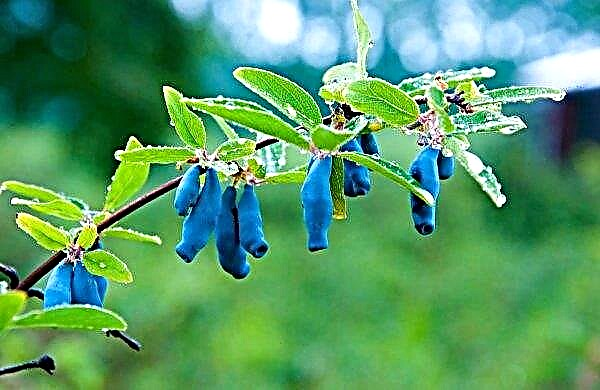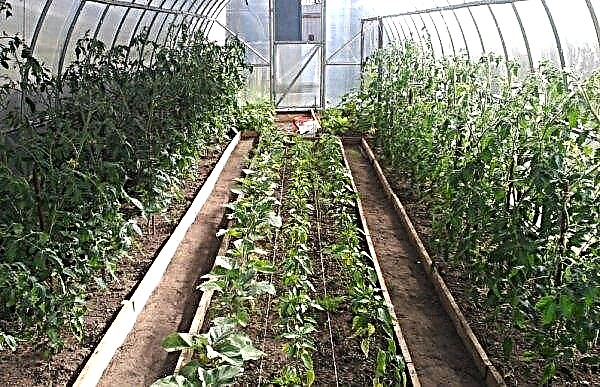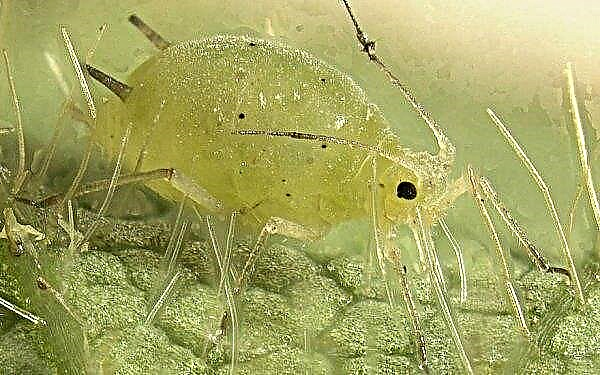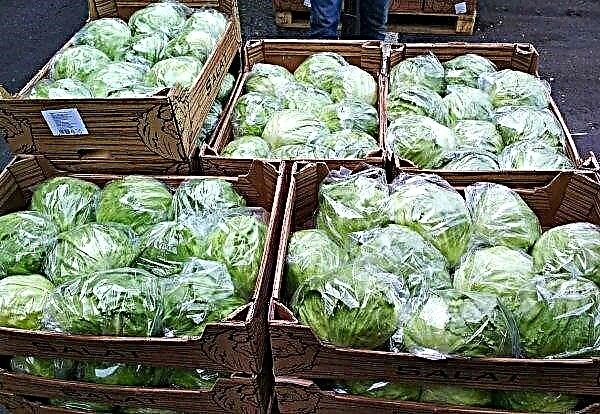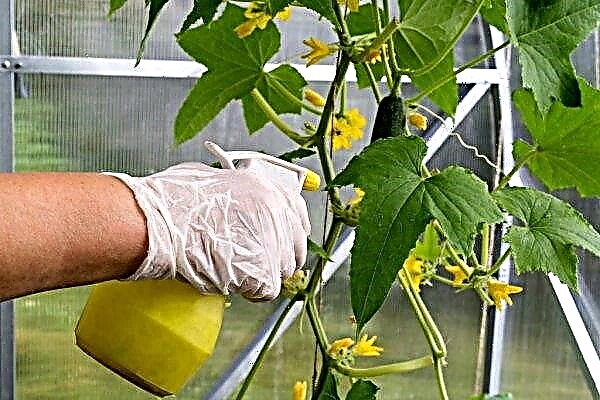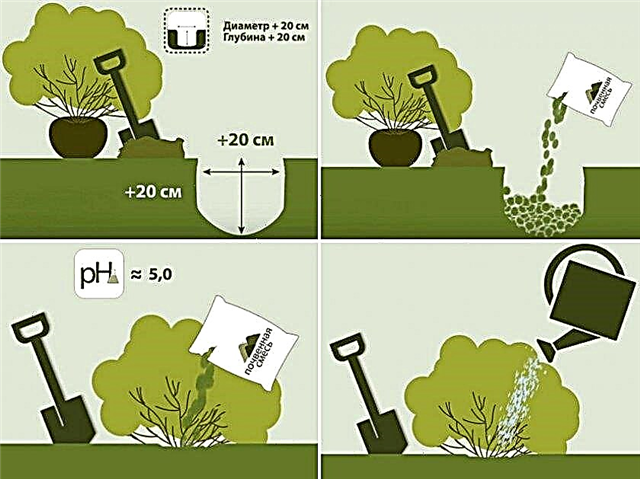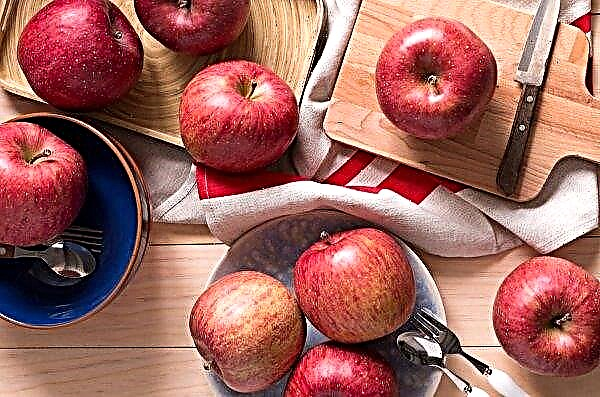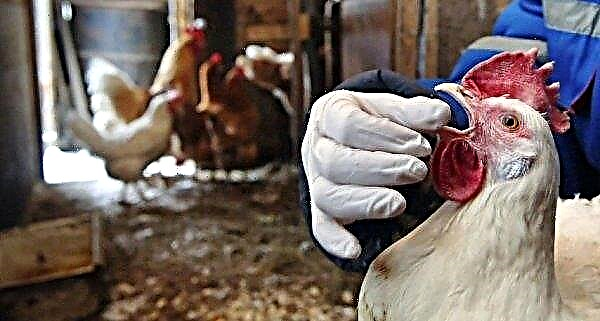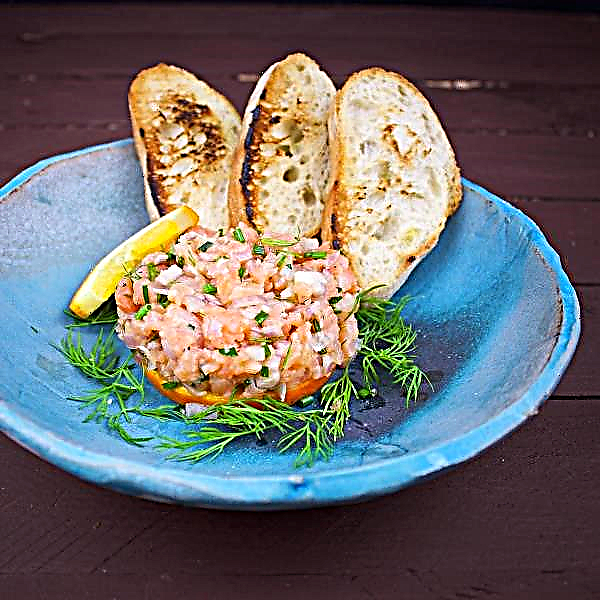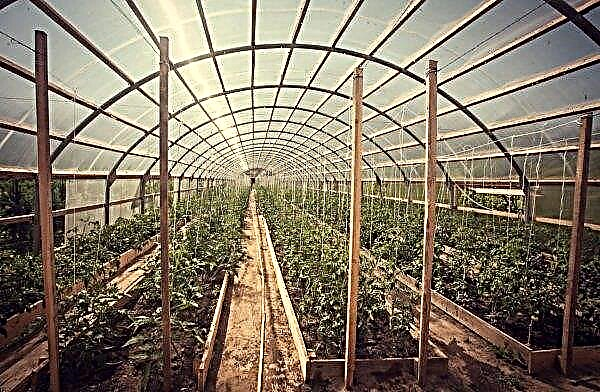Sweet and juicy watermelons appear on sale in August, but sometimes after buying and tasting the fruit it turns out to be bitter in taste. And then the buyer wants to find out why the attractive and ripe stripy berry turned out to be tasteless and what it means. Our article lists the main causes of bitterness of watermelon, the features of its chemical composition, as well as the rules for choosing a ripe and tasty copy.
Chemical composition
Watermelon has a rich chemical composition, which includes a special substance - lycopene. It is it that causes the saturated red color of ripe pulp. In large doses, lycopene can cause an allergic reaction in the human body, but in ripe berries the amount of this substance is very small and only benefits the person.
It improves vision, prevents the development of cancer and speeds up digestion. 100 g of pulp contains only 27 kcal, so the product in question is a dietary one.Did you know? Ripe and large watermelons are often used for carving - artistic clipping. Various objects are cut from the fruits, which are used to decorate the interior.
The nutritional value of 100 g of striped berries is presented below:
- proteins - 0.7 g;
- fats - 0.1 g;
- carbohydrates - 5.8 g;
- dietary fiber - 0.4 g;
- organic acids - 0.1 g;
- water - 92.6 g;
- ash - 0.4 g.
Vitamins and Minerals
The composition of the pulp of watermelon contains a lot of useful vitamins and minerals that positively affect the work of all organ systems in the human body.

The amount of these elements for every 100 g of product is indicated below:
- Vitamin A - 17 mcg;
- thiamine (vitamin B1) - 0.04 mg;
- riboflavin (vitamin B2) - 0.06 mg;
- pyridoxine (vitamin B6) - 0.09 mg;
- folic acid (vitamin B9) - 8 mcg;
- Vitamin C - 7 mg;
- Vitamin E - 0.1 mg;
- vitamin PP - 0.2 mg;
- potassium - 110 mg;
- sodium - 16 mg;
- calcium - 14 mg;
- magnesium - 12 mg;
- phosphorus - 7 mg;
- iron - 1 mg;
- monosaccharides and disaccharides - 5.8 g.
Possible causes of bitterness of watermelon
An unpleasant bitter aftertaste can appear in the flesh of a watermelon for several reasons. Most often, they are associated with errors in storing or growing the fruit, but there is also a sort of striped berry that initially has a bitter taste. Each of these reasons is described in detail later in the article.
Bitter grade
Few people know about the existence of a bitter variety of watermelon - Kolotsinta (Citrullus colocynthis), which is also called bitter cucumber, Sodom vine and wild watermelon. It belongs to the Pumpkin family, and plants in appearance are very similar to sweet varieties.

The fruits of the Kolotsint variety have characteristic differences from the sweet varieties of striped berries:
- watermelons have the shape of a small ball with a diameter of up to 10 cm and weighing no more than 2 kg;
- the smooth and dense peel of unripe specimens is painted green and covered with dark spots, and in ripe fruits the peel acquires a straw-yellow color;
- dense pulp can be white or yellow, but always has a gap in the center;
- the bitter and unpleasant aftertaste is characteristic of the Kolotsint pulp, but it does not have any smell;
- seeds are covered with smooth yellow skin, have a flat ovoid shape and a bitter taste;
- ripening dates of fruits of this variety fall in September or October.
Important! You cannot eat Kolotsint watermelons: their flesh causes severe diarrhea, as it contains toxic substances - glycosides.
Violation of the rules for growing the fetus
Unscrupulous farmers can purposefully use harmful chemicals - nitrates when growing watermelons in order to get a generous harvest and big profits. The ovaries on the plants are treated with nitrate for quick weight gain, injections of watermelon with potassium permanganate to stain the pulp in an attractive red color, etc. Nitrates contribute to the rapid growth of fruits, but interfere with their ripening and impair taste characteristics, as a result of which the flesh becomes bitter.

The main signs of the use of harmful chemicals in the cultivation of the described crop include:
- flesh with rich red color and a slight purple tint;
- the presence of dense yellow fibers extending in the direction from the core to the peel;
- smooth cut surface on pulp, lack of graininess;
- a change in the color of water to pink when a piece of pulp is lowered into it;
- the whole fruit drowns when lowered into a large container with water;
- the presence of small rotten spots of brown color - traces of injections on the peel.
The bulk of nitrates is closer to the crust, therefore, it is not recommended to eat this part of the striped berry as food, and it is better for children to give only the pulp from the core of the fruit.Important! Safe for human health, the amount of nitrates in watermelons is up to 60 mg per 1 kg.
Improper storage
Very often, the flesh of a purchased watermelon leaves bitterness in the mouth after it was stored incorrectly.
The main errors in storing fruits include:
- Using ethylene gas - watermelons are transported over long distances in a torn form and treated with ethylene to increase the shelf life. But after such treatment, the flesh of the berries becomes bitter and loose, coarse fibers appear in it.
- Too long storage of a ripe fruit, as a result of which it deteriorated and lost all its beneficial properties.
- Storage of watermelons with damaged skin - harmful microorganisms quickly penetrate the flesh through cracks, which lead to spoilage of the product and the appearance of bitterness.
- The prolonged presence of incised specimens in conditions of high air temperature, near roads or in direct sunlight - these factors lead to the fact that the flesh quickly deteriorates and bacteria actively multiply in it.

It is sometimes possible to identify fruits that have not been properly stored by their appearance. Dark brown patches appear on the peel of striped berries; upon careful examination, you can see cracks on the peel and feel a specific unpleasant odor.
Is it possible to eat a bitter watermelon?
Regardless of the reason why the purchased product turned out to be bitter, it is impossible to eat it. If the cause of bitterness is the use of nitrates, then the flesh of such a fruit contains a toxic substance - cucurbitacin. It is present in all green striped berries, but by the time they ripen it almost completely disappears.
The use of chemicals contributes to the accelerated growth of the crop, but at the same time, not all cucurbititacin leaves the pulp and can cause serious poisoning of the body. If the specimen you bought is bitter due to improper storage, then this indicates that its flesh has deteriorated and is also not suitable for food.Did you know? In 1981, a square variety of watermelon was developed in Japan, which is distinguished by the convenience of storing ripe fruits.
How to choose the right watermelon
To protect yourself as much as possible from buying a bitter watermelon, you need to know about some of the rules for choosing it.

The ripeness of the fetus is evidenced by a number of external signs, which are listed below:
- watermelons begin to ripen only at the beginning of August, and it is not recommended to buy them earlier than this period - such fruits must have been grown using harmful chemicals;
- the peel should be smooth and even, with a contrasting pattern and without mechanical damage;
- if you rub the skin a little with a fingernail, then it is easily peeled off, and ripe specimens exude a fresh aroma;
- naturally matured specimens weigh about 5–7 kg;
- when tapping the surface of the fetus with your palm, you should hear a resonant resonating sound;
- if you squeeze a ripe copy with your hands, then the peel begins to crack slightly;
- naturally ripened fruits are of medium size and should not be too light or very heavy;
- on the side of a ripe striped berry there is a small spot of yellow or orange color - it indicates that this specimen lay on the ground until natural ripening;
- after ripening a watermelon, its peduncle becomes moderately dry;
- striped berries with a flat lower part with a large circle on it are considered sweeter and juicier than specimens with a convex edge and a small circle.
Important! It is not recommended to buy watermelons near roads or at a point of sale without a canopy - the fruits quickly absorb harmful exhaust gases and deteriorate in direct sunlight.
Eating bitter watermelons is dangerous for the human body, so when buying, you need to pay attention to their appearance. Using the recommendations for choosing the described product listed in the article, you can minimize the risk of buying a tasteless copy and protect yourself from poisoning.

